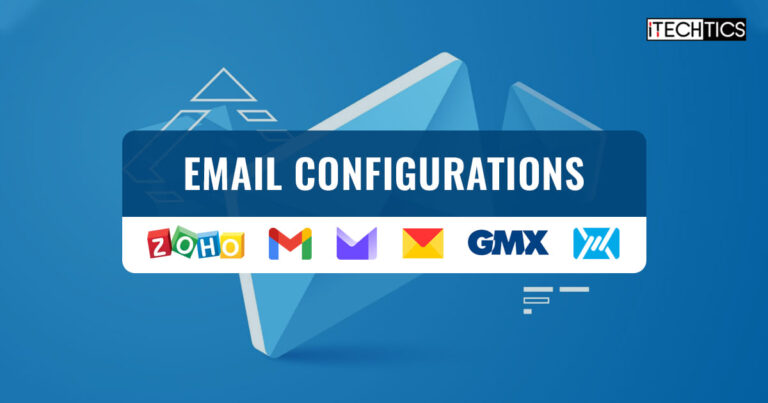When configuring email clients like Outlook and Thunderbird, you need to set up the email accessing and managing protocols to be used. Most email service providers support Internet Messaging Access Protocol (IMAP) and Post Office Protocol 3 (POP3) which can be used for this purpose. However, each handles email access and management differently.
With these protocols, even if the service provider does not have a proprietary email client to access the emails, you can configure third-party email clients to access them.
The Simple Mail Transfer Protocol (SMTP) is a protocol that catches and carries emails to and from mail servers. When configuring an email client, you need to configure either IMAP or POP3 to receive the emails. However, SMTP is used to send messages, which are carried to the mail server.
With this information, additional elements are also required to configure email clients, such as the email server used by the Email Service Provider (ESP), and the port they are using.
In this post, I have listed the configurations that are required to configure email clients by the major ESPs for both ingress and egress emails. Simply click on your Email Service Provider in the content list below and you shall find the IMAP, POP3, and SMTP configurations needed.
Table of Contents
What are IMAP, POP3, and SMTP protocols?
IMAP, POP3, and SMTP protocols all have to deal with emails. IMAP and POP3 protocols access and manage emails on the mail server, while the SMTP protocol transports them.
Here is a brief description of how each protocol works:
- IMAP: This protocol accesses and retrieves emails from the email server to the client. The original emails are still stored on the mail server, and you need internet access to get to them.
- POP3: This protocol also accesses and retrieves emails from the email server, but deletes the original email from the server once it has been received by the client. Since the emails are now stored on your device, they can be accessed offline.
- SMTP: This protocol is responsible for transporting emails. They do not receive or send out emails.
Client configurations for email service providers
Gmail/Google Workspace
Gmail supports both IMAP and POP3 email protocols. These are the settings that you must use within an email client to connect to the email server:
| Protocol | Server | Port | Requires SSL/TLS |
| IMAP | imap.gmail.com | 993 | Requires SSL |
| POP3 | pop.gmail.com | 995 | Requires SSL & TLS |
| SMTP | smtp.gmail.com | 465 (SSL), 587 (TLS) | TLS |
To access Gmail emails through a client, simply configuring the client is not enough. YOu must also enable the POP3 or IMAP protocol from your Gmail account. Here is how to do it:
-
Log into your Gmail account using a browser.
-
Click on the Settings (gear) icon and click “See all settings“.
-
Switch to the “Forwarding and POP/IMAP” tab.
-
Enable the IMAP or POP3 protocol, whichever you wish to use, configure the available settings, and then click “Save changes“.
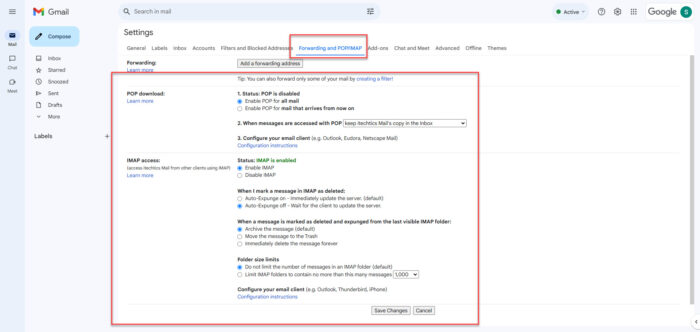
Enable and configure IMAP/POP3 in Gmail
Outlook/Hotmail
If you have an Outlook or Hotmail account, then you need to use the following client configuration settings to access and manage emails from the server. Note that even Microsoft’s proprietary emailing client, Outlook, needs to be configured to access the emails.
That said, Outlook does have the ability to auto-detect the settings, which usually works with Outlook or Hotmail email accounts.
| Protocol | Server | Port | Requires SSL/TLS |
| IMAP | outlook.office365.com | 993 | Requires TLS |
| POP3 | outlook.office365.com | 995 | Requires SSL or TLS |
| SMTP | smtp-mail.outlook.com | 587 | STARTTLS |
Unlike Gmail, you do not need to enable IMAP for a Hotmail/Outlook account. However, you do still need to activate the POP. Here is how to do it:
-
Log into your Hotmail account and click the Settings (Gear) icon in the top-right corner.
-
Switch to the “Sync email” tab.
-
Toggle the slider below “POP and IMAP” into the On position.
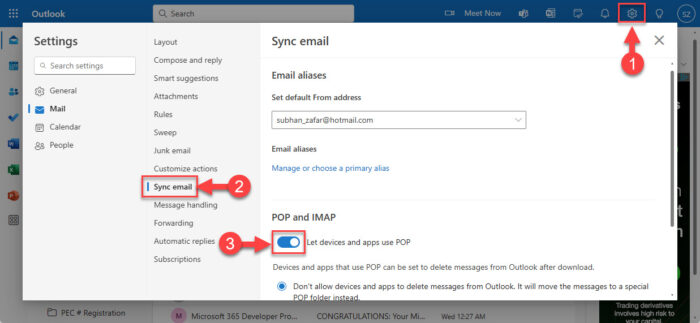
Enable POP on Outlook Hotmail
After performing these steps, if you decide to use POP3 instead of IMAP, you can block devices from deleting emails from the server by selecting the “Don’t allow devices and apps to delete messages from Outlook” option.
Yahoo!
For Yahoo email accounts, you can use the following IMAP, POP3, and SMPT configurations:
| Protocol | Server | Port | Requires SSL/TLS |
| IMAP | imap.mail.yahoo.com | 993 | Requires SSL |
| POP3 | pop.mail.yahoo.com | 995 | Requires SSL |
| SMTP | smtp.mail.yahoo.com | 465 (SSL), 587 (TLS) | Requires SSL or TLS |
Unlike Gmail and Outlook accounts, you do not need to enable IMAP or POP settings in your Yahoo email account.
ProtonMail
ProtonMail is considered one of the most secure email service providers. If you have a paid ProtonMail account, you can use their proprietary email client “Proton Mail Bridge“. This client application is only available for Windows, macOS, and Linux devices.
ProtonMail does not provide server or mail transfer protocol information, so it cannot be configured using third-party email clients. You can also download the ProtonMail app on Android and iOS devices.
That said, ProtonMail does not support POP3 protocol. Therefore, all emails can be accessed using IMAP. However, you can download and export your emails using ProtonMail’s proprietary email client.
Zoho
If you use Zoho Mail as your email service provider, then you can use the following details to configure email clients and access your emails.
Note that the configurations for the incoming servers for both IMAP and POP3 will be different depending if you are a personal user with an email address (user@zoho.com), or an enterprise user with a domain-based email address (user@domain.com).
For personal users
| Protocol | Server | Port | Requires SSL/TLS |
| IMAP | imap.zoho.com | 993 | Requires SSL |
| POP3 | pop.zoho.com | 995 | Requires SSL |
| SMTP | smtp.zoho.com | 465 | Requires SSL or TLS |
For organizational users with domain email
| Protocol | Server | Port | Requires SSL/TLS |
| IMAP | imappro.zoho.com | 993 | Requires SSL |
| POP3 | poppro.zoho.com | 995 | Requires SSL |
| SMTP | smtppro.zoho.com | 465 (SSL), 587 (TLS) | Requires SSL or TLS |
Enable IMAP & POP3 for Zoho Mail
To be able to use third-party email clients for Zoho Mail, you will need to enable IMAP and POP protocols from your email account first. Here is how:
-
Log into Zoho Mail using a web browser and click Settings.
-
Go to “Mail Accounts“.
-
To enable IMAP, check the “IMAP Access” box.
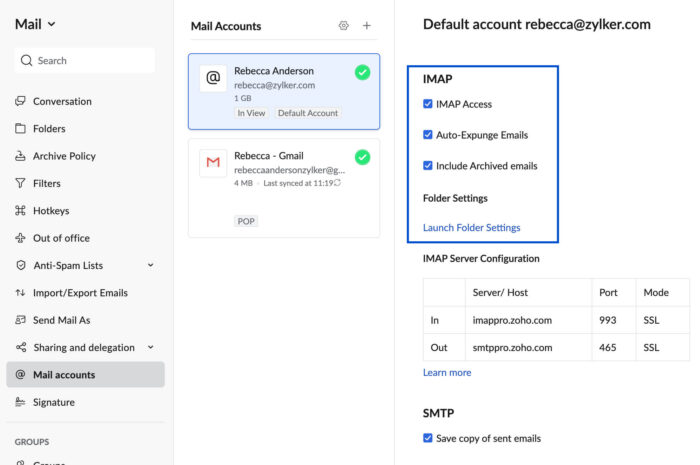
Enable IMAP for Zoho -
To enable POP, go to “POP Access“, and then select either of the following modes:
- All Emails – To enable POP access for all emails in the account – All the emails will be downloaded by the POP client you configure.
- Emails that arrive from now – Enables POP access for emails that arrive from the time the user enables POP access (only the newer emails will be downloaded to the POP client you configure).
AOL
Configuring an email client for an AOL email account is a pretty straightforward process. Here are the SMTP, IMAP, and POP3 details you’ll need to configure it:
| Protocol | Server | Port | Requires SSL/TLS |
| IMAP | imap.aol.com | 993 | Requires SSL |
| POP3 | pop.aol.com | 995 | Requires SSL |
| SMTP | smtp.aol.com | 465 | Requires SSL or TLS |
GMX
The GMX email service provider uses the following email protocol configurations:
| Protocol | Server | Port | Requires SSL/TLS |
| IMAP | imap.gmx.com | 993 | Requires SSL |
| POP3 | pop.gmx.com | 995 | Requires SSL |
| SMTP | mail.gmx.com | 465 (SSL/TLS) or 587 (STARTTLS) | Requires SSL or TLS |
GMX also provides dedicated apps for Android and iOS devices.
That said, you still need to enable IMAP and POP3 access to your GMX account. Here is how to do it:
-
Log into your GMX email account and switch to the Email tab.
-
Click Settings, and then click “POP3 & IMAP“.
-
Select “Enable access to this account via POP3 and IMAP” and save the changes.
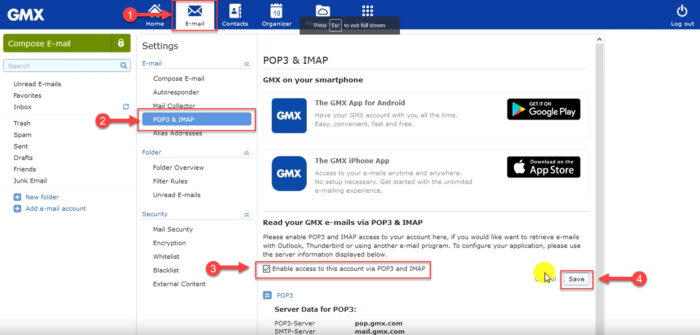
Enable POP and IMAP for GMX account
Neo Mailbox
With Neo Mailbox, you can use the following settings to set up an email client using the IMAP, POP3, and SMTP protocols:
| Protocol | Server | Port | Requires SSL/TLS |
| IMAP | imap0001.neo.space | 993 | Requires SSL or TLS |
| POP3 | pop0001.neo.space | 995 | Requires SSL or TLS |
| SMTP | smtp0001.neo.space | 465 | Requires SSL or TLS |
Fastmail
Fastmail uses the following configuration to set up an email client. However, if you are working behind a firewall, then you may also need some additional configuration, as discussed below.
| Protocol | Server | Port | Requires SSL/TLS |
| IMAP | imap.fastmail.com | 993 | Requires SSL or TLS |
| POP3 | pop.fastmail.com | 995 | Requires SSL or TLS |
| SMTP | smtp.fastmail.com | 465 | Requires SSL or TLS |
As mentioned earlier, if you are working behind a firewall, you might need to perform additional configurations on the firewall to allow IMAP and POP3 communication. You’ll need to allow communication to the following servers:
| IMAP | imaps-proxy.fastmail.com |
| POP3 | pops-proxy.fastmail.com |
| SMTP | smtps-proxy.fastmail.com |
With these servers, you can use several ports for communication, which include 80, 21, 25, and 443.
Tuta
Tuta is another one of the most secure email providers out there. It is so secure that it does not support the IMAP and POP protocols. Instead, it provides its own email client for a variety of different platforms.
Since the emails are encrypted, and Tuta is focused on security and privacy, it is not compatible with third-party email clients.
However, Tuta does provide email clients for Windows, macOS, Linux, iOS, and Android devices.
iCloud
iCloud is Apple’s solution for an emailing service. Although designed for their own platforms, an iCloud account can be linked with third-party clients using IMAP and SMTP. Note that iCloud does not support POP3.
You can use the following information to configure email clients to access and manage iCloud emails:
| Protocol | Server | Port | Requires SSL/TLS |
| IMAP | imap.mail.me.com | 993 | Requires SSL or TLS |
| SMTP | smtp.mail.me.com | 587 | Requires SSL, TLS, or STARTTLS |
Yandex
To configure an email client to access Yandex emails, use these configurations:
| Protocol | Server | Port | Requires SSL/TLS |
| IMAP | imap.yandex.com | 993 | Requires SSL or TLS |
| POP3 | pop.yandex.com | 995 | Requires SSL or TLS |
| SMTP | smtp.yandex.com | 465 | Requires SSL or TLS |
You will also need to enable IMAP or POP3 from your Yandex account to be able to access and manage emails from third-party clients. Here is how:
-
Log into your Yandex account, go to Settings, and then click “Email clients“.
-
For POP, enable the “From pop.yandex.ru server via POP3” option. For IMAP, go to “Use a mail client to retrieve your Yandex mail” and select both “From the imap.yandex.com server via IMAP” and “App passwords and OAuth tokens“.
-
Once done, save the changes.
Titan
For a Titan email account, use this information:
| Protocol | Server | Port | Requires SSL/TLS |
| IMAP | imap.titan.email | 993 | Requires SSL or TLS |
| POP3 | pop.titan.email | 995 | Requires SSL or TLS |
| SMTP | smtp.titan.email | 465 | Requires SSL or TLS |
GoDaddy Workspace Email
GoDaddy hosts emails under the Workspace category, which can be accessed using third-party email clients like Outlook and Thunderbird.
Here are the settings needed to configure an email client with a GoDaddy Workspace email account:
| Protocol | Server | Port | Requires SSL/TLS |
| IMAP | imap.secureserver.net | 993 | Requires SSL |
| POP3 | pop.secureserver.net | 995 | Requires SSL |
| SMTP | smtpout.secureserver.net | 465 or 587 | Requires SSL or TLS |
Bluehost
Bluehost is another domain and email service provider like GoDaddy. If you have an account with Bluehost, you can use IMAP and POP3 protocols to access and manage them.
Note that Bluehost provides 2 kinds of email accounts: A professional cloud-based email account, and a cPanel email account linked with your domain. Both of these account types have different IMAP and POP servers. Use the setting provided below depending on your type of account.
Cloud email account
| Protocol | Server | Port | Requires SSL/TLS |
| IMAP | imap.oxcs.bluehost.com | 993 | Requires SSL or TLS |
| SMTP | smtp.oxcs.bluehost.com | 587 | Requires SSL or TLS |
cPanel email account
Note: “domain.com” implies that you must use your own domain name server as the incoming email server. For example, if your email address is “subhan@itechtics.com”, then your domain is “itechtics.com”.
| Protocol | Server | Port | Requires SSL/TLS |
| IMAP | domain.com | 993 | Requires SSL or TLS |
| POP3 | domain.com | 995 | Requires SSL or TLS |
| SMTP | smtpout.secureserver.net | 465 | Requires SSL or TLS |
In case you do not want to use SSL or TLS, you may use these configurations:
| Protocol | Server | Port | Requires SSL/TLS |
| IMAP | mail.domain.com | 143 | Not required |
| POP3 | mail.domain.com | 110 | Not required |
| SMTP | smtpout.secureserver.net | 26 | Not required |
IONOS Email
For the IONOS email account, you can use the following configurations for a third-party email client:
| Protocol | Server | Port | Requires SSL/TLS |
| IMAP | imap.ionos.com | 993 | Requires SSL or TLS |
| POP3 | pop.ionos.com | 995 | Requires SSL or TLS |
| SMTP | smtp.ionos.com | 465 | Requires SSL or TLS |
Note that the email client and the operating system must support TLS 1.2 or higher. Otherwise, the IMAP and POP3 configurations would not work.
HostGator
HostGator does not have its own incoming or outgoing email servers. Instead, it uses your domain servers for this purpose. Therefore, you need your server name before you can start configuring IMAP, POP3, or SMTP protocols in your email client.
Follow these steps to find your server name:
-
Log into your HostGator account.
-
In the customer portal, click Hosting in the left sidebar.
-
If you only have one hosting package, click “Quick Links“. If you have multiple hosting packages, select the corresponding package and then click Manage.
-
In the “Quick Links” section, click Cpanel.
-
Click “General Information” on the right.
-
Now click “Server Information“.
You will find the name of your server here.
Once you have that, you need to concatenate “hostgator.com” with it, and you will have the complete address of the mail server. For example, if your server name is “abcd”, then the email server address needed for IMP, POP3, and SMTP configuration will be “abcd.hostgator.com”.
Note: This server name has been referred to as “YourServerName” in the table given below.
Now use this table to configure your email client to access and manage your HostGator email account if SSL or TLS is required:
| Protocol | Server | Port | Requires SSL/TLS |
| IMAP | YourServerName | 993 | Requires SSL or TLS |
| POP3 | YourServerName | 995 | Requires SSL or TLS |
| SMTP | <em>YourServerName</em> | 465 | Requires SSL or TLS |
Use the following configuration if SSL or TLS is not required:
| Protocol | Server | Port | Requires SSL/TLS |
| IMAP | YourServerName | 143 | Not required |
| POP3 | YourServerName | 110 | Not required |
| SMTP | <em>YourServerName</em> | 25, 26 | Not required |
Hostinger
If you use Honstinger as your email service provider, then you can use the following parameters to configure a third-party email client to go with it:
| Protocol | Server | Port | Requires SSL/TLS |
| IMAP | imap.hostinger.com | 993 | Requires SSL |
| POP3 | pop.hostinger.com | 995 | Requires SSL |
| SMTP | smtp.hostinger.com | 465 (SSL), 587 (TLS) | Requires SSL or TLS |
DreamHost
For DreamHost, use the following mail servers and ports for email client configuration with SSL or TLS enabled:
| Protocol | Server | Port | Requires SSL/TLS |
| IMAP | imap.dreamhost.com | 993 | Requires SSL |
| POP3 | pop.dreamhost.com | 995 | Requires SSL |
| SMTP | smtp.dreamhost.com | 465 | Requires SSL or TLS |
If you want to configure the client without SSL or TLS requirements, use these parameters instead:
| Protocol | Server | Port | Requires SSL/TLS |
| IMAP | imap.dreamhost.com | 143 | Not required |
| POP3 | pop.dreamhost.com | 110 | Not required |
| SMTP | smtp.dreamhost.com | 587 | Not required |
Of course, using the secure medium with SSL or TLS is always preferred. However, if you encounter issues with the encryption, you can opt to use the parameters without TLS or SSL.
SiteGround
SiteGround uses your domain server as its email server. The nomenclature for the naming of both the incoming and outgoing mail is “mail.yourdomainname.com“. You can thus use the following information to configure third-party email clients with a SiteGround email account:
| Protocol | Server | Port | Requires SSL/TLS |
| IMAP | mail.domainname.com | 993 | Requires SSL |
| POP3 | mail.domainname.com | 995 | Requires SSL |
| SMTP | mail.domainname.com | 465 | Requires SSL or TLS |
If you do not wish to use the secured encryption then you must use the following parameters instead:
| Protocol | Server | Port | Requires SSL/TLS |
| IMAP | mail.domainname.com | 143 | Not required |
| POP3 | mail.domainname.com | 110 | Not required |
| SMTP | mail.domainname.com | 25, 2525 | Not required |
NameCheap Private Email
NameCheap has a division named “Private Email”, which is an email service provider. If you want to configure a NameCheap email account on a third-party email client, use this configuration:
| Protocol | Server | Port | Requires SSL/TLS |
| IMAP | mail.privateemail.com | 993 (SSL), 143 (TLS) | Requires SSL or TLS |
| POP3 | mail.privateemail.com | 995 | Requires SSL |
| SMTP | mail.privateemail.com | 465 (SSL), 587 (TLS) | Requires SSL or TLS |
Amazon Workmail
Amazon Workmail is a big player in the email service provider industry. If you have an account with them, you can use the following parameters to configure a third-party email client to access and manage emails. Note that Amazon Workmail does not currently support the POP3 protocol.
Note: Do not confuse Amazon Workmail with Amazon SES. Amazon SES is an email marketing platform and does not have its own IMAP and POP servers.
| Protocol | Server | Port | Requires SSL/TLS |
| IMAP | imap.mail.us-west-2.awsapps.com (West US) imap.mail.us-east-1.awsapps.com (East US) imap.mail.eu-west-1.awsapps.com (Europe) | 993 | Requires SSL |
| SMTP | smtp.mail.us-west-2.awsapps.com (West US) smtp.mail.us-east-1.awsapps.com (East US) smtp.mail.eu-west-1.awsapps.com (Europe) | 465 | Requires SSL |
Ending words
While you can find the information for POP, IMAP, and SMTP configuration for different service providers online, I have compiled the information for their ports and servers in one location.
Sysadmins and email support providers can use this collection of information to configure all sorts of email clients that support these protocols, regardless of the service provider, or the platform/OS they are configuring it on.
Note that some email service providers mentioned in this post do not support these protocols, but instead, provide their own email clients for different platforms.

